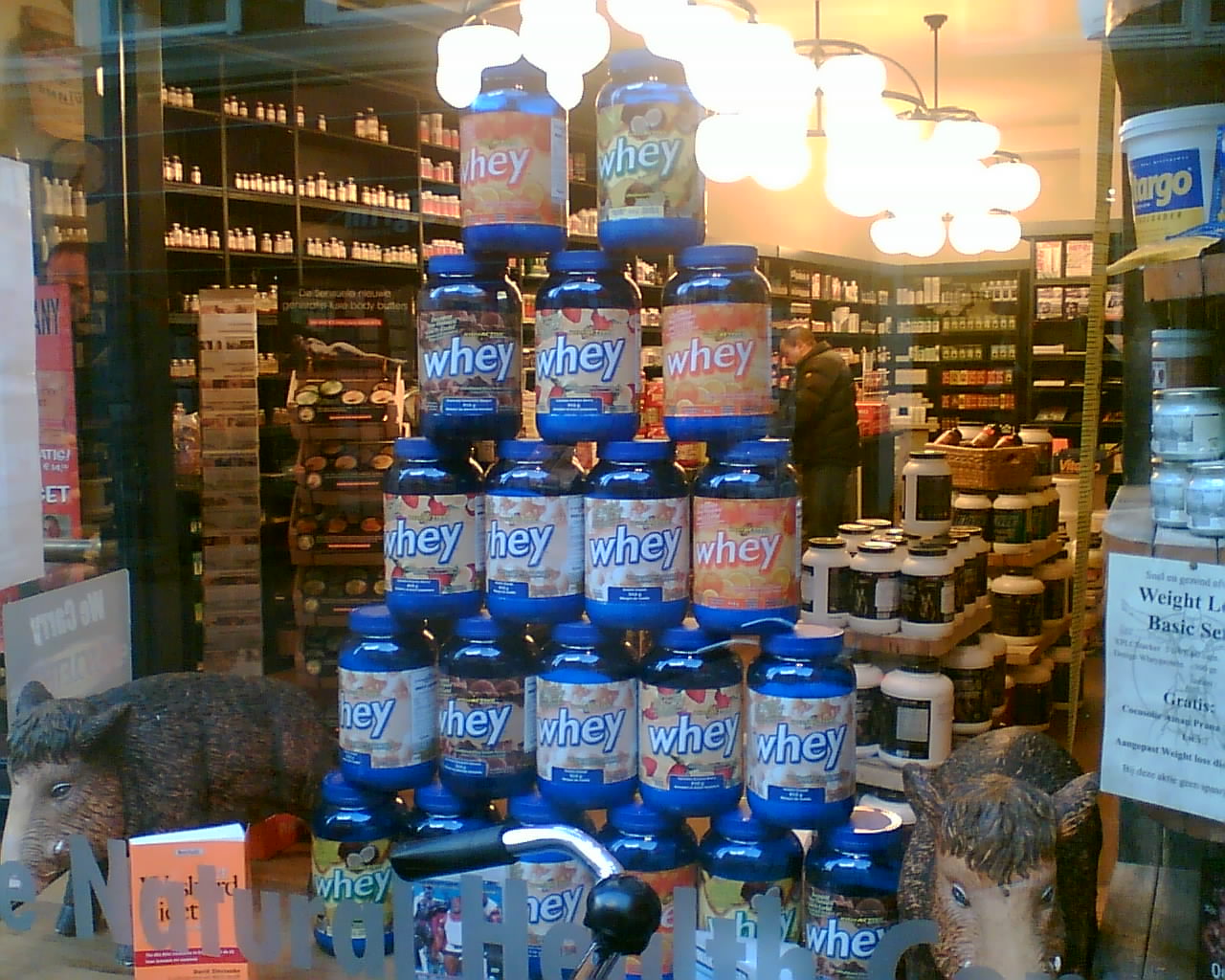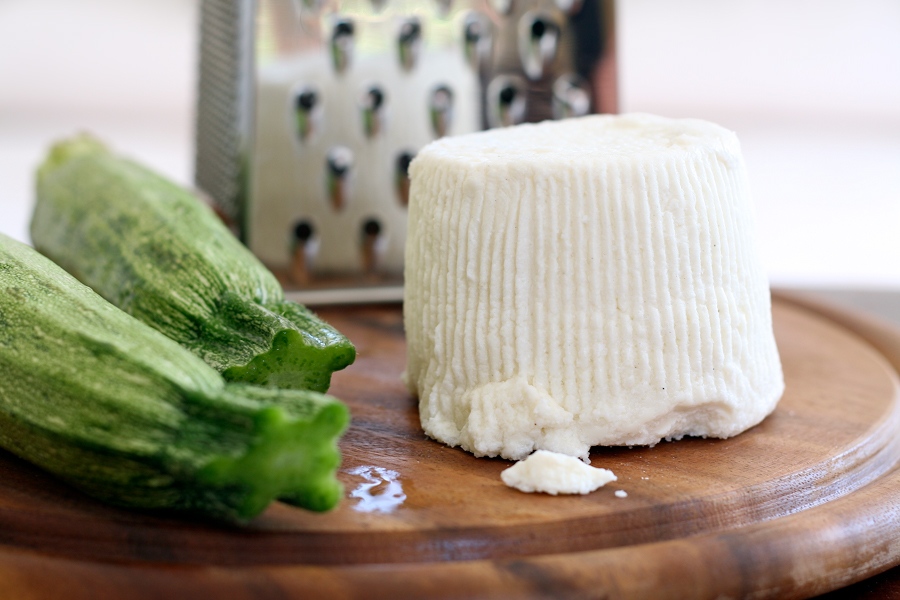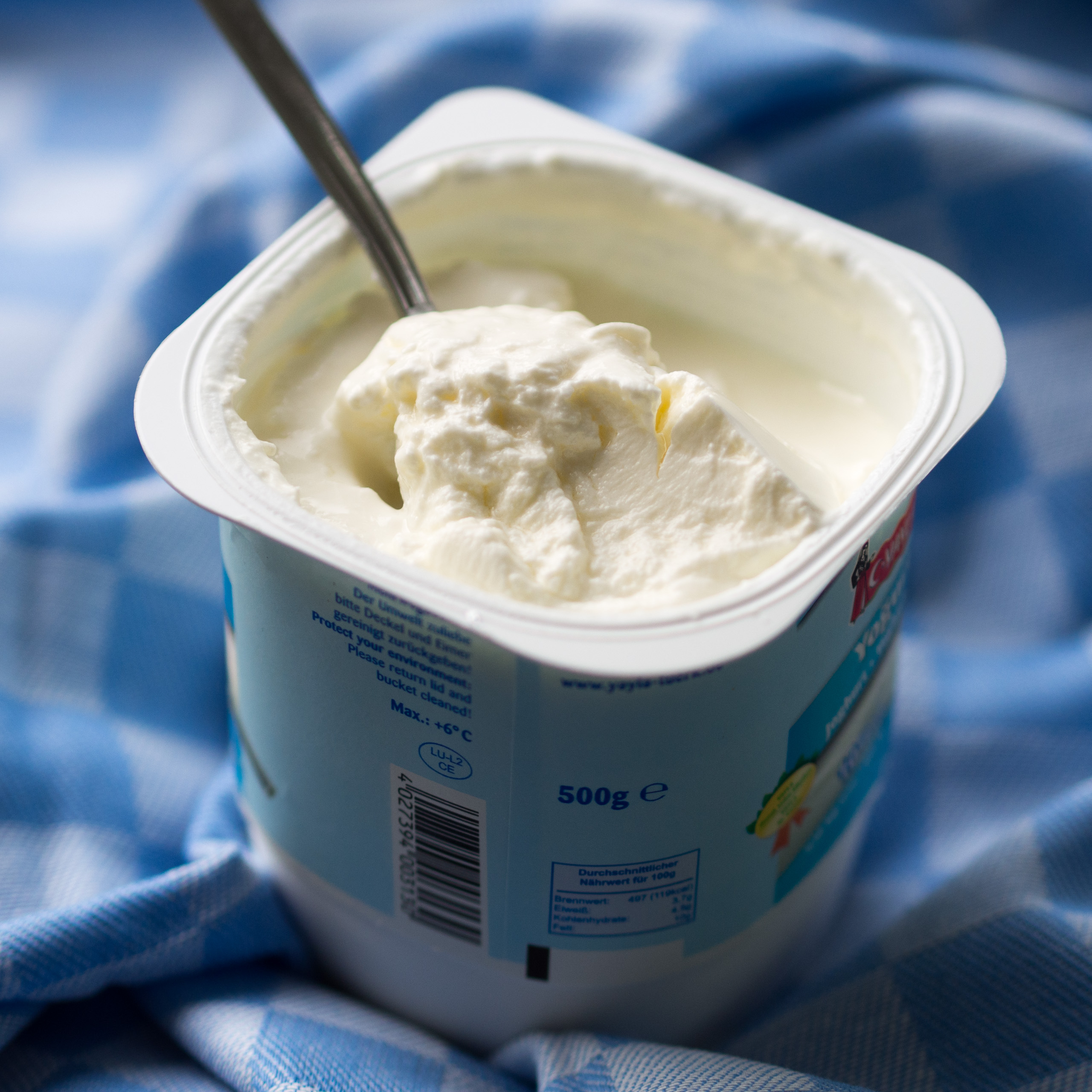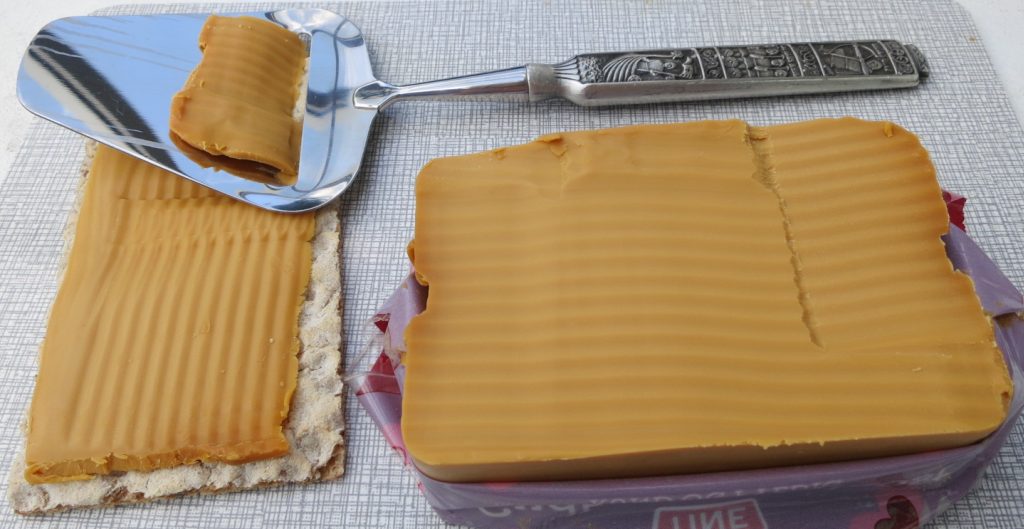|
Whey
Whey is the liquid remaining after milk has been curdled and strained. It is a byproduct of the manufacturing of cheese or casein and has several commercial uses. Sweet whey is a byproduct resulting from the manufacture of rennet types of hard cheese, like cheddar or Swiss cheese. Acid whey (also known as sour whey) is a byproduct brought out during the making of acid types of dairy products, such as strained yogurt. Whey proteins consist of β-lactoglobulin (48%–58%), α-lactalbumin (13%–19%), Glycomacropeptide (12%–20%), bovine serum albumin, heavy and light chain immunoglobulins and several minor whey proteins. Composition Sweet whey and acid whey are similar in gross nutritional analysis. By mass both contain 93% water, about 0.8% protein, and about 5.1% carbohydrates. Sweet whey contains about 0.4% fat while sour whey contains about 0.1% fat. The carbohydrates are mainly lactose. The proteins are known as lactalbumin. Whey also contains some minerals."Whey." ... [...More Info...] [...Related Items...] OR: [Wikipedia] [Google] [Baidu] |
Whey Cheese
Whey is the liquid remaining after milk has been curdling, curdled and strained. It is a byproduct of the manufacturing of cheese or casein and has several commercial uses. Sweet whey is a byproduct resulting from the manufacture of rennet types of hard cheese, like Cheddar cheese, cheddar or Swiss-type cheeses, Swiss cheese. Acid whey (also known as sour whey) is a byproduct brought out during the making of acid types of dairy products, such as strained yogurt. Whey proteins consist of Beta-lactoglobulin, β-lactoglobulin (48%–58%), Α-Lactalbumin, α-lactalbumin (13%–19%), Glycomacropeptide (12%–20%), bovine serum albumin, heavy and light chain immunoglobulins and several minor whey proteins. Composition Sweet whey and acid whey are similar in gross nutritional analysis. By mass both contain 93% water, about 0.8% protein, and about 5.1% carbohydrates. Sweet whey contains about 0.4% fat while sour whey contains about 0.1% fat. The carbohydrates are mainly lactose. The pr ... [...More Info...] [...Related Items...] OR: [Wikipedia] [Google] [Baidu] |
Whey Protein
Whey protein is a mixture of proteins isolated from whey, the liquid material created as a by-product of cheese production. The proteins consist of α-lactalbumin, β-lactoglobulin, serum albumin and immunoglobulins. Glycomacropeptide also makes up the third largest component but is not a protein. Whey protein is commonly marketed as a protein supplement. Production of whey Whey is left over when milk is coagulated during the process of cheese production. Coagulation can happen by adding acid or rennet. It is a 5% solution of lactose in water and contains the water-soluble proteins of milk as well as some lipid content."Whey." The Encyclopædia Britannica. 15th ed. 1994 Processing can be done by simple drying, or the relative protein content can be increased by removing the lactose, lipids and other non-protein materials. The main method to extract protein from whey is membrane filtration. A variety of membrane pore sizes can be used to selectively let different compone ... [...More Info...] [...Related Items...] OR: [Wikipedia] [Google] [Baidu] |
Ricotta
Ricotta () is an Italian whey cheese made from sheep, cow, goat, or Italian water buffalo milk whey left over from the production of other cheeses. Like other whey cheeses, it is made by coagulating the proteins that remain after the casein has been used to make cheese, notably albumin and globulin. Ricotta () protein can be harvested if the whey is first allowed to become more acidic by additional fermentation (by letting it sit for 12–24 hours at room temperature). Then the acidified whey is heated to near boiling. The combination of low pH and high temperature denatures the protein and causes it to flocculate, forming a fine curd. Once cooled, it is separated by passing the liquid through a fine cloth, leaving the curd behind. Ricotta curds are creamy white in appearance, and slightly sweet in taste. The fat content varies depending on the milk used. In this form, it is somewhat similar in texture to some fresh cheese variants, though considerably lighter. It is hi ... [...More Info...] [...Related Items...] OR: [Wikipedia] [Google] [Baidu] |
Strained Yogurt
Strained yogurt, Greek or Greek-style yogurt, yogurt cheese, sack yogurt, kerned yogurt or labneh is yogurt that has been strained to remove most of its whey, resulting in a thicker consistency than normal unstrained yogurt, while still preserving the distinctive sour taste of yogurt. Like many types, strained yogurt is often made from milk enriched by boiling off some water content, or by adding extra butterfat and powdered milk. In Europe and North America, it is often made from low-fat or fat-free cow's milk. In Iceland a similar product named skyr is made. Strained yogurt is usually marketed in North America as "Greek yogurt" and in the United Kingdom as "Greek-style yoghurt", though strained yogurt is also widely eaten in Levantine, Eastern Mediterranean, Middle Eastern, Central Asian, South Asian, and Eastern European cuisines, where it is often used in cooking, as it curdles less readily when cooked. It is used in a variety of dishes, cooked or not, savory or sweet. S ... [...More Info...] [...Related Items...] OR: [Wikipedia] [Google] [Baidu] |
Brunost
' () is a common Norwegian name for (; ; ; ; ''/''), a family of soft cheese-related foods made with whey, milk, and/or cream. The characteristic brown color and sweet taste result from milk sugars being caramelized after boiling. The term is often used to refer to or (' Gudbrandsdal cheese'), which are the most popular varieties. is primarily produced in Norway and is popular there, and has spread to South Korea. It is regarded as one of Norway's most iconic foodstuffs, and is considered an important part of the country's gastronomical and cultural identity and heritage. History Boiling down whey 10:1 to create a brown, cheesy spread (such as the Norwegian and Swedish ) has been common in the Scandinavian countries for at least 2,500 years. An archeological find from September 2016 in central Jutland has determined that a cheese residue on pottery from circa 650 B.C.E. is a type of cheese, potentially similar to . However, the creation of the modern, firm, fatty is ... [...More Info...] [...Related Items...] OR: [Wikipedia] [Google] [Baidu] |
Lactose
Lactose is a disaccharide composed of galactose and glucose and has the molecular formula C12H22O11. Lactose makes up around 2–8% of milk (by mass). The name comes from (Genitive case, gen. ), the Latin word for milk, plus the suffix ''-ose'' used to name sugars. The compound is a white, water-soluble, non-Hygroscopy, hygroscopic solid with a mildly sweet taste. It is used in the food industry. Structure and reactions Lactose is a disaccharide composed of galactose and glucose, which form a β-1→4 Glycosidic bond, glycosidic linkage. Its systematic name is β-D-galactopyranosyl-(1→4)-D-glucose. The glucose can be in either the α-pyranose form or the β-pyranose form, whereas the galactose can have only the β-pyranose form: hence α-lactose and β-lactose refer to the anomeric form of the glucopyranose ring alone. Detection reactions for lactose are the Alfred Wöhlk, Wöhlk and William Fearon, Fearon tests. They can be used to detect the different lactose content o ... [...More Info...] [...Related Items...] OR: [Wikipedia] [Google] [Baidu] |
Milk
Milk is a white liquid food produced by the mammary glands of lactating mammals. It is the primary source of nutrition for young mammals (including breastfeeding, breastfed human infants) before they are able to digestion, digest solid food. Milk contains many nutrients, including calcium and protein, as well as lactose and saturated fat; the enzyme lactase is needed to break down lactose. Immune factors and immune-modulating components in milk contribute to milk immunity. The first milk, which is called colostrum, contains antibody, antibodies and immune-modulating components that milk immunity, strengthen the immune system against many diseases. As an agricultural product, Milking, milk is collected from farm animals, mostly cattle, on a dairy. It is used by humans as a drink and as the base ingredient for dairy products. The US Centers for Disease Control and Prevention, CDC recommends that children over the age of 12 months (the minimum age to stop giving breast milk or Ba ... [...More Info...] [...Related Items...] OR: [Wikipedia] [Google] [Baidu] |
Curd
Curd is obtained by Denaturation (biochemistry), coagulating milk in a sequential process called curdling. It can be a final dairy product or the first stage in cheesemaking. The coagulation can be caused by adding rennet, a Kefir cheese, culture, or any edible acidic substance such as lemon juice or vinegar, and then allowing it to coagulate. The increased acidity causes the milk proteins (casein) to tangle into solid masses, or ''curds''. Milk that has been left to sour (raw milk alone or pasteurized milk with added lactic acid bacteria) will also naturally produce curds, and sour milk cheeses are produced this way. Producing cheese curds is one of the first steps in cheesemaking; the curds are pressed and drained to varying amounts for different styles of cheese and different secondary agents (molds for blue cheeses, etc.) are introduced before the desired aging finishes the cheese. The remaining liquid, which contains only whey proteins, is the whey. In cow's milk, 90 ... [...More Info...] [...Related Items...] OR: [Wikipedia] [Google] [Baidu] |
Cheese
Cheese is a type of dairy product produced in a range of flavors, textures, and forms by coagulation of the milk protein casein. It comprises proteins and fat from milk (usually the milk of cows, buffalo, goats or sheep). During production, milk is usually acidified and either the enzymes of rennet or bacterial enzymes with similar activity are added to cause the casein to coagulate. The solid curds are then separated from the liquid whey and pressed into finished cheese. Some cheeses have aromatic molds on the rind, the outer layer, or throughout. Over a thousand types of cheese exist, produced in various countries. Their styles, textures and flavors depend on the origin of the milk (including the animal's diet), whether they have been pasteurised, the butterfat content, the bacteria and mold, the processing, and how long they have been aged. Herbs, spices, or wood smoke may be used as flavoring agents. Other added ingredients may include black pepper, ... [...More Info...] [...Related Items...] OR: [Wikipedia] [Google] [Baidu] |
Whey Butter
Butter is a dairy product made from the fat and protein components of churned cream. It is a semi-solid emulsion at room temperature, consisting of approximately 81% butterfat. It is used at room temperature as a spread, melted as a condiment, and used as a fat in baking, sauce-making, pan frying, and other cooking procedures. Most frequently made from cow's milk, butter can also be manufactured from the milk of other mammals, including sheep, goats, buffalo, and yaks. It is made by churning milk or cream to separate the fat globules from the buttermilk. Salt has been added to butter since antiquity to help preserve it, particularly when being transported; salt may still play a preservation role but is less important today as the entire supply chain is usually refrigerated. In modern times, salt may be added for taste and food coloring added for color. Rendering butter, removing the water and milk solids, produces clarified butter (including ''ghee''), which is almost enti ... [...More Info...] [...Related Items...] OR: [Wikipedia] [Google] [Baidu] |
Cheddar Cheese
Cheddar cheese (or simply cheddar) is a natural cheese that is relatively hard, off-white (or orange if colourings such as annatto are added), and sometimes sharp-tasting. It originates from the English village of Cheddar, Somerset, Cheddar in Somerset, South West England. Cheddar is produced all over the world, and ''cheddar cheese'' has no Protected designation of origin, Protected Designation of Origin (PDO). In 2007, the name West Country Farmhouse Cheddar was registered in the European Union and (after Brexit) the United Kingdom, defined as cheddar produced from local milk within Somerset, Dorset, Devon and Cornwall and manufactured using traditional methods. Protected Geographical Indication (PGI) was registered for Orkney Scottish Island Cheddar in 2013 in the EU, which also applies under UK law. Globally, the style and quality of cheeses labelled as cheddar varies greatly, with some processed cheeses packaged as "cheddar". Cheeses similar to Red Leicester are sometimes ... [...More Info...] [...Related Items...] OR: [Wikipedia] [Google] [Baidu] |
Glycomacropeptide
Glycomacropeptide (GMP) is a glycosylated peptide formed during renneting as a fragment of sweet whey. Acid whey from yogurt or curdling cheese without the use of rennet does not contain GMP. The unglycosylated form is known as caseinomacropeptide or CMP. Both forms exist in roughly similar amounts in whey. Together GMP and CMP make up 20-25% of whey protein. This makes them the third largest fraction of whey protein isolate, after alpha-lactalbumin and beta-lactoglobulin. GMP is formed when the casein micelle that encapsulates milk protein is cleaved by the enzyme chymosin. The 64 terminal peptides of Kappa-casein are removed by the enzyme to create GMP. The remaining peptides form para-kappa-casein.{{cite journal , last1=Córdova , first1=Dávalos , title=Glycomacropeptide Bioactivity and Health: A Review Highlighting Action Mechanisms and Signaling Pathways , journal=Nutrients , date=March 11, 2019 , volume=11 , issue=3 , page=598 , doi=10.3390/nu11030598 , pmid=30870995 , p ... [...More Info...] [...Related Items...] OR: [Wikipedia] [Google] [Baidu] |











